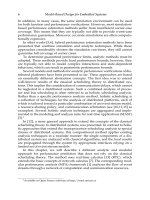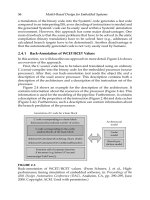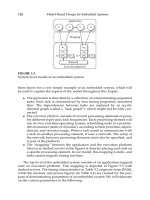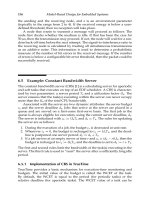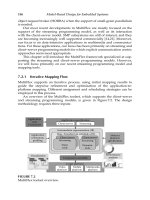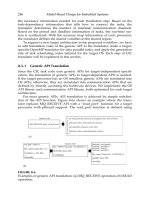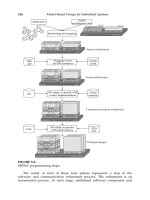Model based design for embedded systems part 19
Bạn đang xem bản rút gọn của tài liệu. Xem và tải ngay bản đầy đủ của tài liệu tại đây (448.82 KB, 10 trang )
156
Model-Based Design for Embedded Systems
the sending and the receiving node, and a is an environment parameter
(typically in the range from 2 to 4). If the received energy is below a userdefined threshold, then no reception will take place.
A node that wants to transmit a message will proceed as follows: The
node first checks whether the medium is idle. If that has been the case for
50 μs, then the transmission may proceed. If not, the node will wait for a random back-off time before the next attempt. The signal-to-interference ratio in
the receiving node is calculated by treating all simultaneous transmissions
as an additive noise. This information is used to determine a probabilistic
measure of the number of bit errors in the received message. If the number
of errors is below a configurable bit-error threshold, then the packet could be
successfully received.
6.5
Example: Constant Bandwidth Server
The constant bandwidth server (CBS) [1] is a scheduling server for aperiodic
and soft tasks that executes on top of an EDF scheduler. A CBS is characterized by two parameters: a server period Ts and a utilization factor Us . The
server ensures that the task(s) executing within the server can never occupy
more than the Us of the total CPU bandwidth.
Associated with the server are two dynamic attributes: the server budget
cs and the server deadline ds . Jobs that arrive at the server are placed in a
queue and are served on a first-come first-serve basis. The first job in the
queue is always eligible for execution, using the current server deadline, ds .
The server is initialized with cs := Us Ts and ds = Ts . The rules for updating
the server are as follows:
1. During the execution of a job, the budget cs is decreased at unit rate.
2. Whenever cs = 0, the budget is recharged to cs := Us Ts , and the deadline is postponed one server period: ds := ds + Ts .
3. If a job arrives at an empty server at time r and cs ≥ (ds − r)Us , then the
budget is recharged to cs := Us Ts , and the deadline is set to ds := r + Ts .
The first and second rules limit the bandwidth of the task(s) executing in the
server. The third rule is used to “reset” the server after a sufficiently long idle
period.
6.5.1 Implementation of CBS in TrueTime
TrueTime provides a basic mechanism for execution-time monitoring and
budgets. The initial value of the budget is called the WCET of the task.
By default, the WCET is equal to the period (for periodic tasks) or the
relative deadline (for aperiodic tasks). The WCET value of a task can be
TrueTime: Simulation Tool for Performance Analysis
157
changed by calling ttSetWCET(value,task). The WCET corresponds to
the maximum server budget, Us Ts , in the CBS. The CBS period is specified
by setting the relative deadline of the task. This attribute can be changed by
calling ttSetDeadline(value,task).
When a task executes, the budget is decreased at unit rate. The
remaining budget can be checked at any time using the primitive
ttGetBudget(task). By default, nothing happens when the budget
reaches zero. In order to simulate that the task executes inside a CBS, an execution overrun handler must be attached to the task. A sample initialization
script is given below:
function node_init
% Initialize kernel, specifying EDF scheduling
ttInitKernel(0,0,’prioEDF’);
% Specify CBS rules for initial deadlines and initial
budgets
ttSetKernelParameter(’cbsrules’);
% Specify CBS server period and utilization factor
T_s = 2;
U_s = 0.5;
% Create an aperiodic task
ttCreateTask(’aper_task’,T_s,1,’codeFcn’);
ttSetWCET(T_s*U_s,’aper_task’);
% Attach a WCET overrun handler
ttAttachWCETHandler(’aper_task’,’cbs_handler’);
The execution overrun handler can then be implemented as follows:
function [exectime,data] = cbs_handler(seg,data)
% Get the task that caused the overrun
t = ttInvokingTask;
% Recharge the budget
ttSetBudget(ttGetWCET(t),t);
% Postpone the deadline
ttSetAbsDeadline(ttGetAbsDeadline(t)+ttGetDeadline(t),t);
exectime = -1;
If many tasks are to execute inside CBS servers, the same code function can
be reused for all the execution overrun handlers.
6.5.2 Experiments
The CBS can be used to safely mix hard, periodic tasks with soft, aperiodic
tasks in the same kernel. This is illustrated in the following example, where
a ball and beam controller should execute in parallel with an aperiodically
triggered task. The Simulink model is shown in Figure 6.6.
158
Model-Based Design for Embedded Systems
FIGURE 6.6
TrueTime model of a ball and beam being controlled by a multitasking realtime kernel. The Poisson arrivals trigger an aperiodic computation task.
The ball and beam process is modeled as a triple integrator disturbed by
white noise and is connected to the TrueTime kernel block via the A/D and
D/A ports. A linear-quadratic Gaussian (LQG) controller for the ball and
beam has been designed and is implemented as a periodic task with a sampling period of 10 ms. The computation time of the controller is 5 ms (2 ms
for calculating the output and 3 ms for updating the controller state). A Poisson source with an intensity of 100/s is connected to the interrupt input of
the kernel, triggering an aperiodic task for each arrival. The relative deadline of the task is 10 ms, while the execution time of the task is exponentially
distributed with a mean of 3 ms.
The average CPU utilization of the system is 80%. However, the aperiodic
task has a very uneven processor demand and can easily overload the CPU
during some intervals. The control performance in the first experiment, using
plain EDF scheduling, is shown in Figure 6.7. A close-up of the corresponding CPU schedule is shown in Figure 6.8. It is seen that the aperiodic task
sometimes blocks the controller for several sampling periods. The resulting
execution jitter leads to very poor regulation performance.
Next, a CBS is added to the aperiodic task. The server period is set to
Ts = 10 ms and the utilization to Us = 0.49, implying a maximum budget
(WCET) of 4.9 ms. With this configuration, the CPU will never be more than
99% loaded. A new simulation, using the same random number sequences
as before, is shown in Figure 6.9. The regulation performance is much
159
TrueTime: Simulation Tool for Performance Analysis
Output
0.05
0
−0.05
0
1
2
3
4
5
6
7
8
9
10
0
1
2
3
4
5
Time
6
7
8
9
10
Input
50
0
–50
Aperiodic task
FIGURE 6.7
Control performance under plain EDF scheduling.
0.05
0.1
0.15
0.2
0.25
0.3
0.35
0.4
0.45
0.5
0
0.05
0.1
0.15
0.2
0.25
Time
0.3
0.35
0.4
0.45
0.5
Controller
0
FIGURE 6.8
Close-up of CPU schedule under plain EDF scheduling.
better—this is especially evident in the smaller control input required. The
close-up of the schedule in Figure 6.10 shows that the controller is now able
to execute its 5 ms within each 10 ms period and the jitter is much smaller.
6.6
Example: Mobile Robots in Sensor Networks
In the EU/IST FP6 integrated project RUNES (reconfigurable ubiquitous networked embedded systems, [32]) a disaster-relief road-tunnel scenario was
used as a motivating example [5]. In this scenario, mobile robots were used
160
Model-Based Design for Embedded Systems
Output
0.05
0
−0.05
0
1
2
3
4
5
6
7
8
9
10
0
1
2
3
4
5
Time
6
7
8
9
10
Input
50
0
−50
Aperiodic task
FIGURE 6.9
Control performance under CBS scheduling.
0.05
0.1
0.15
0.2
0.25
0.3
0.35
0.4
0.45
0.5
0
0.05
0.1
0.15
0.2
0.25
Time
0.3
0.35
0.4
0.45
0.5
Controller
0
FIGURE 6.10
Close-up of CPU schedule under CBS scheduling.
as mobile radio gateways that ensure the connectivity of a sensor network
located in a road tunnel in which an accident has occurred. A number of
software components were developed for the scenario. A localization component based on ultrasound was used for localizing the mobile robots and
a collision-avoidance component ensured that the robots did not collide (see
[2]). A network reconfiguration component [30] and a power control component [37] were responsible for deciding the best position for the mobile
robot in order to maximize radio connectivity, and to adjust the radio power
transmit level.
In parallel with the physical implementation of this scenario, a TrueTime
simulation model was developed. The focus of the simulation was the timing
TrueTime: Simulation Tool for Performance Analysis
161
aspects of the scenario. It should be possible to simultaneously simulate the
computations that take place within the nodes, the wireless communication
between the nodes, the power devices (batteries) in the nodes, the sensor
and actuator dynamics, and the dynamics of the mobile robots. In order to
model the limited resources correctly, the simulation model must be quite
realistic. For example, it should be possible to simulate the timing effects of
interrupt handling in the microcontrollers implementing the control logic of
the nodes. It should also be possible to simulate the effects of collisions and
contention in the wireless communication. Because of simulation time and
size constraints, it is at the same time important that the simulation model is
not too detailed. For example, simulating the computations on a source-code
level, instruction for instruction, would be overly costly. The same applies to
simulation of the wireless communication at the radio-interface level or on
the bit-transmission level.
6.6.1 Physical Scenario Hardware
The physical scenario consists of a number of hardware and software components. The hardware consists of the stationary wireless communication
nodes and the mobile robots. The wireless communication nodes are implemented by Tmote Sky sensor network motes executing the Contiki operating system [14]. In addition to the ordinary sensors for temperature, light,
and humidity, an ultrasound receiver has been added to each mote (see
Figure 6.11).
The two robots, RBbots, are shown in Figure 6.12. Both robots are
equipped with an ultrasound transmitter board (at the top). The robot to the
left has the obstacle-detection sensors mounted. This consists of an IR proximity sensor mounted on an RC-servo that sweeps a circle segment in front
of the robot and a touch sensor bar.
The RBbots internally consist of one Tmote Sky, one ATMEL AVR
Mega128, and three ATMEL AVR Mega16 microprocessors. The nodes communicate internally over an I2 C bus. The Tmote Sky is used for the radio
communication as the master. Two of the ATMEL AVR Mega16 processors
are used as interfaces to the wheel motors and the wheel encoders measuring
the wheel angular velocities. The third ATMEL AVR Mega16 is used as the
interface to the ultrasound transmitter and to the obstacle-detection sensors.
The AVR Mega128 is used as a compute engine for the software-component
code that does not fit the limited memory of the TMote Sky. The structure is
shown in Figure 6.13.
6.6.2 Scenario Hardware Models
The basic programming model used for the TI MSP430 processor used
in the Tmote Sky systems is event-driven programming with interrupt
162
Model-Based Design for Embedded Systems
FIGURE 6.11
Stationary sensor network nodes with ultrasound receiver circuit. The node
is packaged in a plastic box to reduce wear.
FIGURE 6.12
The two Lund RBbots.
TrueTime: Simulation Tool for Performance Analysis
163
TMote Sky
Obstacledetection
sensors
ATMEL AVR
Mega16
ATMEL AVR
Mega128
ATMEL AVR
Mega16
ATMEL AVR
Mega16
Ultrasound
transmitter
Left wheel
motor &
encoder
Right wheel
motor &
encoder
FIGURE 6.13
RBbot hardware architecture.
handlers for handling timer interrupts, bus interrupts, etc. In TrueTime,
the same architecture can be used. However, the Contiki OS also supports
protothreads [15], lightweight stackless threads designed for severely
memory-constrained systems. Protothreads provide linear code execution
for event-driven systems implemented in C. Protothreads can be used to
provide blocking event-handlers. They provide a sequential flow of control
without complex-state machines or full multithreading. In TrueTime, protothreads are modeled as ordinary tasks. The ATMEL AVR processors are
modeled as event-driven systems. A single nonterminating task acts as the
main program and the event handling is performed in interrupt handlers.
The software executing in the TrueTime processors is written in C++. The
names of the files containing the code are input parameters of the network
blocks. The localization component consists of two parts. The distance sensor
part of the component is implemented as a (proto-)thread in each stationary
sensor node. An extended Kalman filter–based data fusion is implemented
in the Tmote Sky processor on board each robot. The localization method
makes use of the ultrasound network and the radio network. The collisionavoidance component code is implemented in the ATMEL AVR Mega128
processor using events and interrupts. It interacts over the I2 C bus with the
localization component and with the robot-position controller, both located
in the Tmote Sky processor.
164
Model-Based Design for Embedded Systems
6.6.3 TrueTime Modeling of Bus Communication
The I2 C bus within the RBbots is modeled in TrueTime by a network block.
The TrueTime network model assumes the presence of a network interface
card or a bus controller implemented either in the hardware or the software
(i.e., as drivers). The Contiki interface to the I2 C bus is software-based and
corresponds well to the TrueTime model. In the ATMEL AVRs, however, it is
normally the responsibility of the application programmer to manage all bus
access and synchronization directly in the application code. In the TrueTime
model, this low-level bus access is not modeled. Instead, it is assumed that
there exists a hardware or a software bus interface that implements this.
Although the I2 C is a multimaster bus that uses arbitration to resolve conflicts, this is not how it is modeled in TrueTime. On the Tmote Sky, the radio
chip and the I2 C bus share connection pins. Because of this, it is only possible to have one master on the I2 C bus and this master must be the Tmote
Sky. All communication must be initiated by the master. Because of this,
bus access conflicts are eliminated. Therefore, the I2 C bus is modeled as a
CAN bus with the transmission rate set to match the transmission rate of the
I2 C bus.
6.6.4 TrueTime Modeling of Radio Communication
The radio communication used by the Tmote Sky is the IEEE 802.15.4
MAC protocol (the so-called Zigbee MAC protocol) and the corresponding TrueTime wireless network protocol was used. The requirements on
the simulation environment from the network reconfiguration and radio
power–control components are that it should be possible to change the
transmit power of the nodes and that it should be possible to measure the received signal strength, that is, the so-called received signal
strength indicator (RSSI). The former is possible through the TrueTime
command, ttSetNetworkParameter(’transmitpower’,value). The
RSSI is obtained as an optional return value of the TrueTime function,
ttGetMsg.
In order to model the ultrasound, a special block was developed. The
block is a special version of the wireless network block that models the ultrasound propagation of a transmitted ultrasound pulse. The main difference
between the wireless network block and the ultrasound block is that in the
ultrasound block it is the propagation delay that is important, whereas in
the ordinary wireless block it is the medium access delay and the transmission delay that are modeled. The ultrasound is modeled as a single sound
pulse. When it arrives at a stationary sensor node an interrupt is generated.
This also differs from the physical scenario, in which the ultrasound signal is
connected via an AD converter to the Tmote Sky.
The network routing is implemented using a TrueTime model of the ad
hoc on-demand vector (AODV) routing protocol (see [31]) commonly used
TrueTime: Simulation Tool for Performance Analysis
165
in sensor network and mobile robot applications. The AODV uses three
basic types of control messages in order to build and invalidate routes: route
request (RREQ), route reply (RREP), and route error (RERR) messages. These
control messages contain source and destination sequence numbers, which
are used to ensure fresh and loop-free routes. A node that requires a route
to a destination node initiates route discovery by broadcasting an RREQ
message to its neighbors. A node receiving an RREQ starts by updating its
routing information backward toward the source. If the same RREQ has not
been received before, the node then checks its routing table for a route to the
destination. If a route exists with a sequence number greater than or equal to
that contained in the RREQ, an RREP message is sent back toward the source.
Otherwise, the node rebroadcasts the RREQ. When an RREP has propagated
back to the original source node, the established route may be used to send
data. Periodic hello messages are used to maintain local connectivity information between neighboring nodes. A node that detects a link break will
check its routing table to find all routes that use the broken link as the next
hop. In order to propagate the information about the broken link, an RERR
message is then sent to each node that constitutes a previous hop on any of
these routes.
Two TrueTime tasks are created in each node to handle the AODV send
and receive actions, respectively. The AODV send task is activated from the
application code, as a data message should be sent to another node in the network. The AODV receive task handles the incoming AODV control messages
and forwarding of data messages. Communication between the application
layer and the AODV layer is handled using TrueTime mailboxes. Each node
also contains a periodic task, responsible for broadcasting hello messages
and determining local connectivity based on hello messages received from
neighboring nodes. Finally, each node has a task to handle the timer expiry
of route entries.
The AODV protocol in TrueTime is implemented in such a way that it
stores messages to destinations for which no valid route exists, at the source
node. This means that when, eventually, the network connectivity has been
restored through the use of the mobile radio gateways, the communication
traffic will be automatically restored.
6.6.5 Complete Model
In addition to the above, the complete model for the scenario also contains
models of the sensors, motors, robot dynamics, and a world model that keeps
track of the position of the robots and the fixed obstacles within the tunnel.
The wheel motors are modeled as first-order linear systems plus integrators with the angular velocities and positions as the outputs. From the motor
velocities, the corresponding wheel velocities are calculated. The wheel
positions are controlled by two PI-controllers residing in the ATMEL AVR
processors acting as interfaces to the wheel motors.

